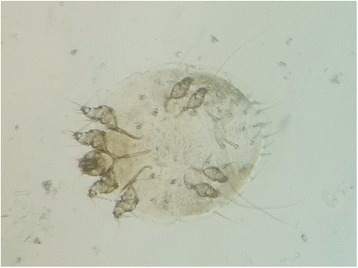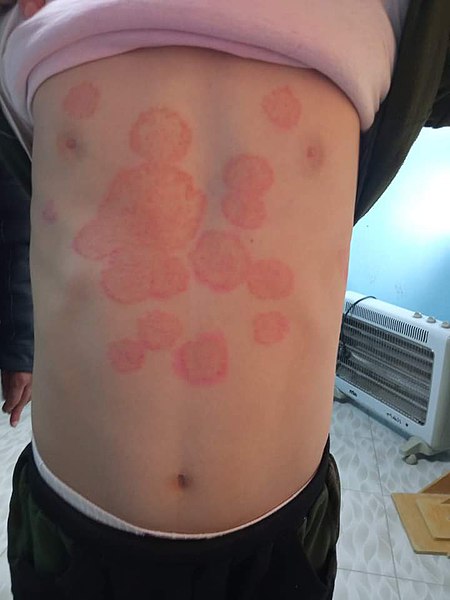Playlist
Show Playlist
Hide Playlist
Onychomycosis (Nail fungus) and Scabies (Sarcoptic Mange)
-
Slides Dermatology Infectious Disorders.pdf
-
Reference List Pathology.pdf
-
Download Lecture Overview
00:01 The topic here is onychomycosis. 00:03 What does that mean? It’s a fungal infection of nail plate or nail bed. 00:08 If it’s one thing that you want take out of this fungal infection, onycho- means nail. 00:13 Caused by dermatophytes or some saprophytes. 00:19 Fungal infection of the nail bed. 00:22 Demographics: 20% will be of the elderly, onychomycosis. 00:27 Causes a thickened, dystrophic and discolored nail, with crumbling, and it’s called onycholysis. 00:36 So the onychomycosis at some point when it then affects your nail bed, you cause destruction of it, we call this onycholysis. 00:45 Note the only cause of dystrophic nail is onychomycosis, usually dermatophyte or maybe a saprophyte. 00:56 If you then take look at the nail here on your left, you’d find this to be a very dystrophic nail in onychomycosis. 01:06 Diagnosis: Must prove the diagnosis before treatment, and may perform as you can imagine, a KOH prep or nail biopsy. 01:16 Management: You need to make sure that you at first confirm it. 01:20 And once you do, know that often treatment is restricted to the finger nail. 01:27 Diabetics and those with ambulatory issues, and by that we mean what? Difficulty with movement. 01:37 Requires oral antifungals for prolonged course. 01:40 Once again, we have terbinafine or an azole drug as itraconazole. 01:49 Scabies. 01:50 A scabies infestation of the mite – The name of the mite here is called your Sarcoptes scabiei. 01:58 Healthy persons may only have a dozen mites on the entire body whereas an immunocompromised individual get crusted scabies with millions of mites. 02:09 Doesn’t that sound like a wonderful, wonderful discovery? So what does this look like on your skin with scabies? Female mites, they burrow into the superficial skin and there they go and plop! They drop feces and eggs. 02:24 Pleasant. 02:26 Allergic reaction occurs in the material that’s been produced by the mite. 02:31 Pruritic rash with the presence of small linear type of burrows. 02:36 And then the burrow often found where? The wrist or between the fingers, in the webs of the fingers. 02:45 In an adult, the face, neck and scalp are typically spared, is something that you want to keep in mind. 02:54 Here’s a patient that has scabies and I want you to focus upon – This is a baby and you’ll notice that it’s on the legs, it’s on the chest, and you’ll also find it in between the fingers and the webs of the fingers. 03:06 Scabies, remember the female mite? It got in there and dropped its eggs or maybe feces and then there’s an allergic reaction in which this poor child was scratching, scratching, scratching. 03:20 Diagnosis: Scabies prep using a scalpel blade and the burrows are scraped. 03:27 Examination of your material underneath the microscope and the mites, the eggs, and the feces are then diagnostic, obviously. 03:36 Remember, immunocompetent maybe a few dozen, maybe a dozen. 03:41 If it’s in immunocompromised, we’re talking about millions with those crusts. 03:48 Management: Topical permethrin. 03:52 Ivermectin, oral. 03:54 Family members for sure and launder the linens forevermore. 03:59 Burn them if you need to.
About the Lecture
The lecture Onychomycosis (Nail fungus) and Scabies (Sarcoptic Mange) by Carlo Raj, MD is from the course Infectious Skin Diseases. It contains the following chapters:
- Onychomycosis
- Scabies
Included Quiz Questions
A 44-year-old woman with an intensely pruritic rash has multiple small, erythematous papules and excoriations, and serpiginous lines are visible on the wrists, waist, and genitalia, as well as in the interdigital spaces. What test will help in diagnosing this condition?
- Skin scraping and microscopic examination
- Potassium hydroxide preparation
- Blood test for scabies
- Tzanck smear
- Wood lamp examination
What is the first-line treatment for classical scabies in adults?
- Topical permethrin
- Oral griseofulvin
- Topical clotrimazole
- Topical steroids
- Oral Itraconazole
Customer reviews
5,0 of 5 stars
| 5 Stars |
|
5 |
| 4 Stars |
|
0 |
| 3 Stars |
|
0 |
| 2 Stars |
|
0 |
| 1 Star |
|
0 |





